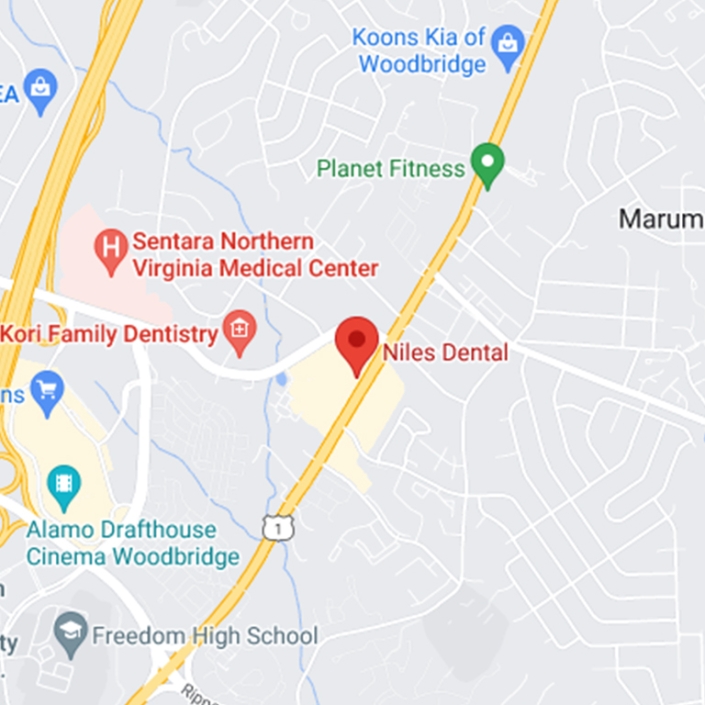Tooth Extractions in Woodbridge, VA

Although Dr. Raymond Niles and Dr. Kathryn Niles-Smith do everything possible to preserve your natural teeth, sometimes tooth extractions in Woodbridge VA are necessary to maintain good oral health. Your dentist may recommend removing one or more teeth for the reasons we outline below.
Do You Need a Tooth Extracted?
Before starting orthodontic treatment, some patients need to have one or more teeth extracted to make room for the other teeth to shift. Since we also offer orthodontic services, Dr. Niles or Dr. Kathryn Niles-Smith can complete the extractions themselves. Here are some other reasons why it may be best to remove a natural tooth:
- Impacted wisdom teeth
- Infection in a tooth that has reached the bone and caused decay
- Severe tooth decay that our dentists cannot treat with a crown, filling, or other type of restoration
- Severely cracked or chipped tooth that we cannot repair
We discuss several tooth replacement options during your consultation to help you decide which one would be most appropriate for your treatment goals.
What to Expect During Your Appointment for a Tooth Extraction
We care about your comfort at Niles Dental, which is why we offer several options for painkillers and sedation. Most people opt for general anesthesia, which consists of a numbing gel that one of our dentists or a hygienist applies to the gums surrounding your tooth. A dentist or hygienist then administers several small injections at the treatment site to numb the area.
Although the anesthesia dulls pain receptors, you will still feel some movements like pulling and tugging on your tooth. You also remain awake throughout the extraction procedure. We reserve general anesthesia for people with severe dental anxiety or those with special physical or emotional health needs that would make cooperation during the procedure difficult or impossible.
With general anesthesia, you receive an IV in your arm that temporarily puts you to sleep. Our staff keeps track of your heart rate, blood pressure, and breathing rate until one of our dentists completes the extraction.
Sedation Options
Besides anesthesia to ease your discomfort, you can also opt for light to moderate sedation for additional pain and anxiety relief. Laughing gas, also known as nitrous oxide, is a popular choice for this procedure. If you request laughing gas, we place a hard mask over your mouth and nose containing oxygen and a sedative. We ask you to breathe in normally until you feel relaxed. The effect wears off as soon as we finish the extraction, and you are free to drive yourself home.
Dr. Niles or Dr. Niles-Smith can also prescribe a sedative in pill form that you take shortly before your appointment. You remain awake, yet calm and drowsy, if you choose this sedation option. Your dentist may recommend IV sedation for more complex extractions.
The Procedure
You may need a simple extraction or a surgical extraction, depending on the location of the tooth, the health of its roots, and other individual factors. During a simple extraction, Dr. Niles or Dr. Niles-Smith uses a piece of handheld equipment called a dental elevator to loosen the tooth in its socket. Your dentist then pulls the tooth from the gums with forceps. You will feel pressure but should not feel pain during this process.
Surgical Tooth Extraction
After ensuring that the anesthesia has taken effect, Dr. Niles or Dr. Niles-Smith start the procedure by making a small incision in your gums. You may have the bone of the tooth removed at the same time if it blocks access to its roots. Some teeth are easier to remove with a single pull than others. You should not feel alarmed if we must break your tooth into pieces to remove it.
Final Steps
Whether you have a simple or surgical extraction performed, your dentist cleans your gums, places a fresh gauze pad at the extraction site, and asks you to bite down to control the bleeding. The bleeding will be less extensive if you receive stitches, but you should plan to keep a clean gauze pad in your mouth for at least half an hour after you get home.
You should expect to have some pain and discomfort for a few days after tooth extractions in Woodbridge VA. Most people find adequate relief by taking a combination of Ibuprofen and a non-prescription pain reliever like Tylenol. Applying a cold pack to your cheek for 20 minutes at a time also helps to decrease the swelling.
If pain after a tooth extraction persists for more than three days, you may have developed a dry socket. This condition occurs when you do not form a blood clot at the extraction site, or the clot becomes dislodged and exposes your bone. Although a dry socket is painful, placing a medicated gauze pad at the extraction site and continuing with non-prescription pain relievers is usually enough to help you feel better.
Please reach out to Niles Dental with additional questions or to request an appointment.

